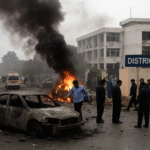1. The Hidden Storm: Why Lahore’s Air Is Turning Toxic
Every October, Lahore wakes up under a dull orange sky that smells like burnt plastic. What looks like fog is actually poison — thick layers of PM 2.5 smog drifting from both sides of the border.
As of October 2025, Lahore’s AQI hit 412, ranking it among the most polluted cities in the world. Schools were shut, highways slowed to a crawl, and even the early-morning sun turned red behind the haze.
But here’s the question: how much of this pollution is home-grown, and how much is imported from across the border?
2. The Real Culprits Behind Lahore’s Pollution
2.1. Seasonal Weather Traps
Cool air, weak winds, and temperature inversions keep pollutants locked near the ground — forming a “toxic lid” over the city.
2.2. Local Emissions & Urban Chaos
-
Diesel trucks and aging vehicles
-
Brick kilns and small factories
-
Garbage and open waste burning
-
Construction dust from rapid expansion
2.3. Cross-Border Air from India 🇮🇳
Each October–November, winds push stubble-burning smoke from India’s Punjab and Haryana into Pakistani Punjab. Satellite imagery and wind models confirm that this drift adds a dangerous layer of haze over Lahore, Kasur, and Okara.
2.4. Weak Enforcement & Public Awareness
Despite the efforts of Punjab’s environment department, inconsistent enforcement and poor awareness continue to fuel the smog cycle.
3. What the 2025 Data Reveals
According to the latest readings from IQAir and Pakistan Environmental Protection Agency, Lahore’s Air Quality Index (AQI) has remained dangerously high throughout October 2025 — averaging 395–415, well above the “hazardous” threshold.
When compared to Delhi and Faisalabad, Lahore consistently records the worst daily air quality in South Asia this season. Analysts attribute this spike to a combination of stagnant local emissions and smoke drifting from Indian stubble-burning fields.
4. How the Toxic Air Is Hurting Lives
-
Health: asthma, lung infections, and chronic fatigue are on the rise.
-
Economy: reduced outdoor work hours, higher healthcare spending, and flight delays.
-
Lifestyle: visibility drops sharply; children and elderly suffer the most.
5. What We Can Do: Practical & Real Solutions
5.1. At Home
-
Seal windows and doors during high-AQI days.
-
Use air purifiers or DIY HEPA filters.
-
Grow indoor plants such as snake plant or areca palm.
5.2. Outdoors
-
Always wear an N95 mask.
-
Avoid early-morning walks when smog peaks.
-
Check daily AQI through IQAir or Pakistan’s official app.
5.3. Community Action
-
Report illegal waste or field burning.
-
Support green-energy use in kilns and factories.
-
Raise awareness — this isn’t “fog,” it’s toxic air.
6. Local vs Cross-Border Pollution: A Data Comparison
| Source | Description | Local Lahore Impact | Cross-Border Impact (India) |
|---|---|---|---|
| Vehicles | Cars, trucks, bikes | High | Low |
| Industry | Kilns, factories | High | Moderate |
| Crop burning | Post-harvest fires | Medium | Very High |
| Weather & wind | Seasonal inversion | High | Carries smoke westward |
| Construction | Urban expansion | High | — |
7. People Also Ask
Q: Why blame India for Lahore’s smog?
Because wind trajectories show smoke drifting westward from Indian Punjab during the crop-burning season.
Q: Will this smog clear soon?
Only heavy rain or stronger winds can clear it — until then, Lahore stays under a toxic cloud.
Q: What mask should I wear in Lahore?
Use N95 or KN95 masks; cloth masks cannot block fine particulate matter.
Q: Does staying indoors protect me fully?
Not completely — indoor air also needs filtering or ventilation with purifiers.
Q: Has Pakistan taken action internationally?
Yes, Islamabad has raised the cross-border pollution issue at regional and global climate forums in 2025.
8. Final Thoughts: Breathing Hope into the Horizon
Let’s face it — this isn’t “just winter fog.” It’s a man-made crisis.
But with cooperation between Pakistan and India, stricter laws, and citizen awareness, clean air is still within reach.










